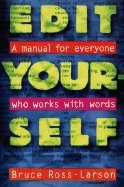What do you think?
Rate this book


Paperback
First published November 4, 1985
The great thing about libraries is you get to read books that you don't own. Another benefit? You get to evaluate books you might want to own if you like them. One example of the latter is "Edit Yourself: A Manual for Everyone Who Works with Words" by Bruce Ross-Larson.
